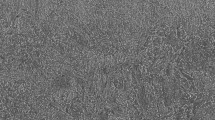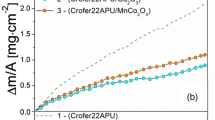Abstract
A very-low-sulfur-content industrial Fe−Cr−Al alloy has been used both as a baseline and as a charge material for laboratory metlts with variable sulfur and rare-earth additions. No significant differences in behavior were observed in cyclic oxidation tests on 1-mm-thick coupons at 1100°C, except for an excessive rare-earth content, which led to accelerated scale growth. At 1300°C, alloys without rare-earth additions developed high growth stresses in the oxide, leading to large tensile strains in the substrate. The oxide-metal interface in the low-sulfur (<2ppm) material resisted these stresses and the oxide remained adherent. However, as little as 4ppm S was sufficient to cause considerable spalling. Rare-earth additions markedly reduced growth stresses and eliminated both dimensional instability and spalling.
Similar content being viewed by others
References
D. P. Whittle and J. Stringer,Philos. Trans. R. Soc. London A 295, 304–329 (1980).
H. Hindam and D. P. Whittle,Oxid. Met. 18, 245–284 (1982).
K. N. Strafford,High Temp. Tech. 1, 307–318 (1983).
F. H. Stott and G. C. Wood,Mater. Sci. Eng. 87, 267–274 (1987).
A.-M. Huntz, inThe Role of Active Elements in the Oxidation Behaviour of High Temperature Metals and Alloys, E. Lang, ed. (Elsevier, London, 1988), pp. 81–109.
A. W. Funkenbusch, J. G. Smeggil, and N. S. Bornstein,Met. Trans. A. 16, 1164–1166 (1985).
J. G. Smeggil, A. W. Funkenbusch, and N. S. Bornstein,Met. Trans. A. 17, 923–932 (1986).
D. G. Lees,Oxid. Met. 27, 75–81 (1987).
J. L. Smialek,Met. Trans. A. 18, 164–167 (1987).
R. Sigler,Oxid. Met. 29, 23–43 (1988).
J. L. Smialek,Met. Trans. A. 22, 739–752 (1991).
P. Y. Hou and J. Stringer,Oxid. Met. 38, 323–345 (1992).
J. H. Davidson, inThe Role of Active Elements in the Oxidation Behaviour of High Temperature Metals and Alloys, E. Lang, ed. (Elsevier, London, 1988), pp. 353–365.
Author information
Authors and Affiliations
Rights and permissions
About this article
Cite this article
Forest, C., Davidson, J.H. Some observations on the effects of sulfur and active elements on the oxidation of Fe−Cr−Al alloys. Oxid Met 43, 479–490 (1995). https://doi.org/10.1007/BF01046894
Received:
Revised:
Issue Date:
DOI: https://doi.org/10.1007/BF01046894




